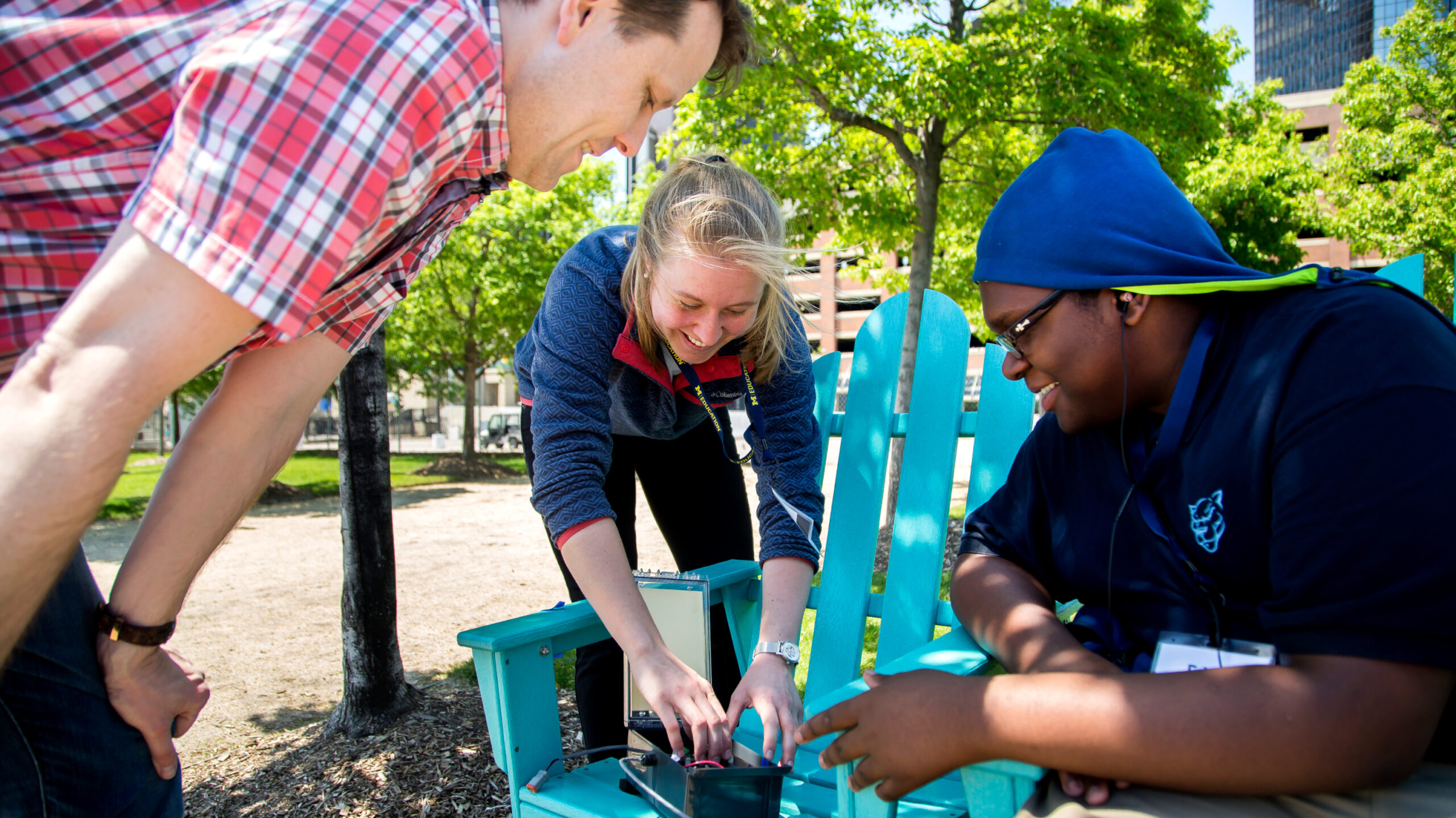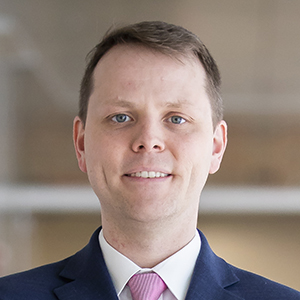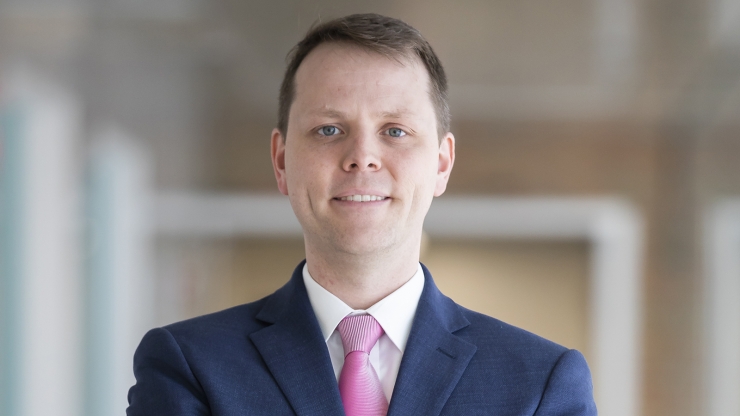Engineering for Impact: Meet Duke Engineering’s Next Dean
From Duke Engineering Communications
Jerome Lynch shares his perspectives on Duke Engineering, initial priorities as dean, and vision for the transformative role engineers can play in society

In January 2022, Jerome Lynch will take the reins of Duke’s Pratt School of Engineering as our next Vinik Dean.
An authority in the use of smart technologies to improve civil infrastructure, Lynch is also an advocate for community engagement in research and an entrepreneur. He currently serves as chair of the University of Michigan (U-M) Department of Civil and Environmental Engineering and co-director of U-M’s Urban Collaboratory, a research institute that partners with city leaders and residents to design inclusive solutions to community challenges.
Following the recent announcement of his appointment, Lynch sat down with us for a conversation about his perspectives on Duke Engineering, his initial priorities as dean, and his vision for the transformative role engineers can play in society in the years ahead.
Welcome to Duke, and congratulations on your appointment as Vinik Dean of Engineering! Tell us more about what drew you to the role.
Related News
Jerome Lynch Named New Dean of Pratt School of Engineering
Following a national search, Lynch’s appointment was announced in September 2021
For me, the institution itself, including its work, people and traditions, is the major draw. The Pratt School of Engineering is a real innovator in both education and research—there is deep expertise across its four departments and excellence in very strategic, high-impact areas such as biomedical engineering, advanced computing, materials and environmental health, to name just a few. At the same time, it’s situated in a university of broad excellence across diverse disciplines like medicine, law, policy, business and the arts and sciences.
I think that as we move deeper into the 21st century it’s really important for engineers to think holistically about the very complex societal problems ahead of us that we are aiming to solve. Pratt has a proven capacity to push the envelope and to create revolutionary technologies to help solve these challenges. But because of its intellectual breadth, Duke is extremely well-positioned to tackle those problems not only technologically, but also in a broader manner that’s highly effective in ensuring society is truly bettered through our solutions. That is really my biggest motivator for serving as dean, to lead the kinds of broad-based initiatives, with innovation and technology at their core, that will have a transformative impact on our world.
What are some of the big opportunities you see ahead for engineers and engineering as a field?
One very ripe opportunity for engineers is to think intentionally about developing solutions in collaboration with the stakeholders most affected by our work—to be ‘socially engaged engineers,’ if you will. I feel strongly that this is a way to strengthen our identity as a profession, as well as enhance the impact of the diverse range of expertise we offer as engineers.
Many areas that Duke has deep strength in are greatly needed and offer opportunities for continued growth. Just a couple of examples are in the biomedical arena, to enhance health outcomes and quality of life, and in AI, which is providing an exciting new set of tools that engineers can use to revolutionize how we analyze data and automate many of the systems the world depends upon.
Another area where there’s tremendous opportunity, and one that’s particularly urgent, is climate change. Whether we’re going to see a one-and-a-half or three-degree centigrade increase in the earth’s temperature by this century’s end, it’s introducing some very profound and troubling changes in the security of our communities, ranging from flooding hazards in coastal communities to water scarcity and food security in arid regions of the globe. I think engineers can bring forth the breakthrough discoveries and technologies to not only design systems that can adapt to these changes, but even to reverse climate change.
And there are questions around social equity in our society. That’s clearly a very, very broad challenge that all disciplines need to lean in on. But I think engineers have a vital role to play in terms of being thoughtful about the equity of the solutions we design for all members of our society. We must have at the forefront of our mind this question when we consider the impact of our work: are we ensuring that the benefits extend equitably to all?
“My biggest motivator for serving as dean is to lead the kinds of broad-based initiatives, with innovation and technology at their core, that will have a transformative impact on our world.”
During the search process you spoke with a number of Duke Engineering stakeholders and learned more about current initiatives to move the school forward. For example, in the past year, our community engaged in an aspirational visioning exercise called Pratt 2039 as the first phase of a strategic process to maximize the school’s potential in the years leading up to our centennial. At the same time, we’ve launched significant diversity, equity, inclusion and community (DEIC) initiatives internally and externally. And the school is an integral part of the Duke Science and Technology (DST) faculty hiring and fundraising effort to elevate excellence in the sciences at Duke.
Can you talk about how these initial learnings have shaped your sense of the opportunities ahead for Duke Engineering, and your first priorities as dean?
Absolutely. I was so impressed with what I learned throughout the search process, and really enjoyed hearing more about the things the community cares deeply about. I was truly inspired by all of those conversations I had with the faculty, staff, students and alumni.
There is a strong focus on the power of collaboration here at Duke. With DST for example, Duke is bringing in resources to recruit outstanding faculty to give us competitive advantage in key strategic areas like materials, computing and resilience of the body and brain, but I think the initiative is equally impressive for the way it is designed to spur collaborations across the entirety of the Duke campus. Building interfaces is also a central idea in the Pratt 2039 visioning exercise—there’s a strong emphasis on creating robust ecosystems around our research and education programs to ensure our work is getting out there to benefit the larger world, whether it’s with industry, the local community, other educational institutions in the state, or global partners.
Another area that stands out across both the university and the school, including in the Pratt 2039 vision, is the institutional commitment to diversity, equity and inclusion [DEI]. This has been a priority for me at U-M, where my department is in the second year of a five-year DEI action plan that is having a tremendous positive impact on our academic community. It is also creating partnership opportunities that amplify our effort—for example, we partnered with industry to launch a scholarship program for domestic graduate students who have demonstrated a commitment to diversity in their life experiences and work. I think it’s essential that we represent the communities that we work in and create environments where all individuals can thrive. That’s the way we bring in the diverse perspectives that result in creative, impactful solutions previously unimaginable.
“Engineers have a vital role to play in terms of being thoughtful about the equity of the solutions we design for all members of our society. We must have at the forefront of our mind this question when we consider the impact of our work: are we ensuring that the benefits extend equitably to all?”
In terms of other priorities, since I’m new to the Duke family, one of the first things will certainly be to continue learning about the programs and the people who drive those programs forward. Really, just getting to know everybody. Another will be to advance the school’s strategic vision to the next phase, working with the team to confirm broad consensus in terms of priorities, develop operational plans for executing on those ideas, and clearly defining how we will measure successful outcomes.
Again, it’s clear that societal impact is valued at Duke and will be a huge part of how we measure our success as an institution. Obviously, there are important details to work out in how we do ‘engineering in service to society’ in the way that’s right for Duke and right for the communities we work with. But there’s tremendous opportunity there, and I want to ensure that Duke Engineering is at the vanguard.
Meet Jerome “Jerry” Lynch
- Hometown: Queens, New York
- Alma Maters:
- Stanford University (PhD and MS, Civil & Environmental Engineering; MS, Electrical Engineering)
- The Cooper Union (BE, Civil & Environmental Engineering)
- Family:
- Nadine Wong, spouse and Managing Director, University of Michigan Biointerfaces Institute
- Claire, daughter, a fifth-grader
- Charlie, a two-year-old Cavachon dog
- Extracurriculars:
- Summer travels with family (favorite destination: Mauritius)
- Baking artisan bread
- Working out
- Now reading: The British Are Coming: The War for America, by Rick Atkinson (“It’s a fantastic book, the first part of a trilogy about the American Revolution. I actually rediscovered an interest in this period through my daughter, who is a huge Hamilton fan. I also enjoy fiction and reading The Economist.”)
- Looking forward to: “Getting to know Durham and exploring historical sites in this area of the country.”

Building impactful collaborations with industry and community partners has been a big part of your own career as engineer, researcher and entrepreneur. What drives you to keep reaching outside the proverbial ivory tower?
Well, as engineers, we love to develop solutions to problems. But translating technologies into practice is important if we want those innovations to have impact. There are many ways to do that, from sponsored research and licensing agreements with industry partners, to entrepreneurship, where Duke Engineering has been a clear global leader. I was fortunate in my own career to have the opportunities to develop startups based on my research, first at Stanford when I was a student, and a second as a faculty member at Michigan. These were simply wonderful experiences that were made possible by strong entrepreneurial ecosystems associated with both schools. And I believe that Duke offers one of the most vibrant and dynamic innovation ecosystems in the country—the possibilities for its students, staff, faculty and external partners are truly unlimited. More broadly, with the exciting expansion happening so rapidly in the Research Triangle today, Duke is supremely positioned to leverage its entrepreneurial infrastructure to partner with other technology leaders to spur and accelerate regional innovation.
Working with community partners, engineers can see the impact of their work in a different way. A lot of communities are facing challenges that really could benefit from innovation and technology being brought to the table. That was my original motivation for beginning to work with communities more directly through U-M’s Urban Collaboratory, but in the process, I’ve learned a tremendous amount. It gives you a deep appreciation of the complexities of introducing solutions in the real world—the economics of the solution, the political ramifications of its implementation, and the need for compliance with policies and regulations. Contextualizing one’s work in that way makes you a better engineer. For me, working with communities has been one of the most rewarding experiences of my career. When you do achieve success with a community partner and begin to hand off a solution, it’s almost a spiritual experience that reaffirms that engineering is your calling.
“I believe that Duke offers one of the most vibrant and dynamic innovation ecosystems in the country—the possibilities for its students, staff, faculty and external partners are truly unlimited. More broadly, with the exciting expansion happening so rapidly in the Research Triangle today, Duke is supremely positioned to leverage its entrepreneurial infrastructure to partner with other technology leaders to spur and accelerate regional innovation.”
Is there a particular example that stands out?
Sensor in a Shoebox was really meaningful to me. This was a program that taught youth in Detroit how to use wireless sensor technologies to analyze problems they see at the community level, such as poor air quality or assessing the walkability of their neighborhoods. Detroit is going through a phenomenal transformation from a traditional post-industrial Midwestern city into one that’s embracing entrepreneurship because of the way financial constraints had contracted city structures. It became a sort of do-it-yourself type of city where creative and passionate communities boldly sought to solve problems locally, without dependence on city government. In Shoebox we built on that DIY culture by offering communities access to data while expanding their capacity to explore solutions in partnership with other city stakeholders.
How do you see this kind of external engagement benefiting engineering students?
At a practical level students gain valuable problem-solving skills from working on projects with communities, but they also get to see the kind of impact they can have as future engineering professionals. It’s a powerful way to encourage more students to pursue engineering. These are students who are looking to change the world and they’re trying to find a discipline that gives them the best pathway to position them for global impact.
This is a big reason I’m excited about Duke Engineering—it has a unique curriculum and educational philosophy that really emphasizes the importance of teaching students through doing. Even as early as the first year, they’re working on projects with real clients through First Year Design, and then that’s carried across the four years with experiential, hands-on courses and projects in a way that is incredibly impactful. I think it’s the right way to train engineers to be at the vanguard of innovation, technology and delivering the solutions that society needs. It also builds into our students a stronger sense of purpose as they make decisions about their career and where they want to focus their energy.
Given your interests in community impact, industry engagement and entrepreneurship, what led you to pursue a career in academia?
Truthfully, I never thought I would go into academia. When I decided to do my PhD, I envisioned going more into an entrepreneurial space after graduation. In fact, that is why I launched a startup partway through my PhD. But at the end of the day, I always gravitated toward research, the opportunity for intellectual growth and driving innovation in that space. I also love teaching and sparking the same excitement that I have for engineering in others. So by the time I finished my PhD, academia was really the only option I was seriously considering.
I think academia has changed in recent decades—it’s opened up different venues for academics to have impact. We see it in the space of entrepreneurship where technology translation to the marketplace is valued as much as paper citations. In the early years of my career, I had a number of opportunities to lead projects that were larger than my own work or my own lab, whether it was a multi-university research center or initiatives that engaged industry in joint partnerships. Those experiences gave me confidence that I could be an effective leader driving collaboration across different boundaries, whether between the sub-disciplines of engineering or between academia and external stakeholders like industry or policymakers. Given my interest in being a technology leader focused on broad collaboration, I applied for the chair position in my department, and it’s been an incredibly rewarding experience.
It’s a difficult role, but it’s one that has a lot of joy associated with it. Your role changes from thinking about your own work in the lab and classroom, to thinking about how you empower others to succeed in those arenas. At the same time, you think about moving the profession forward, and ensuring that your students are well-positioned to realize those exciting futures. Those were new experiences for me as a chair, but I enjoyed all aspects of it, and I see the dean’s position as an opportunity to do that at a larger scale. So I’m really excited and grateful to be asked to serve as the engineering dean at Duke. I’m looking forward to the possibilities in the “outrageously ambitious” Duke community.

